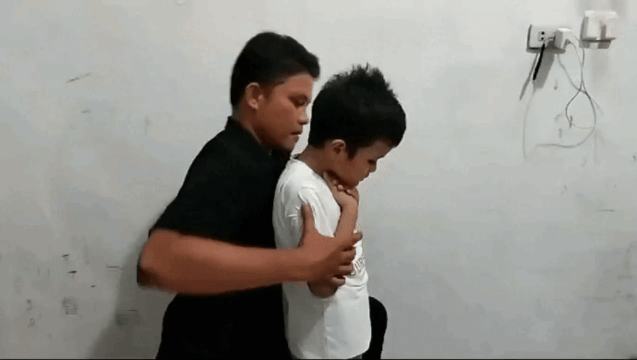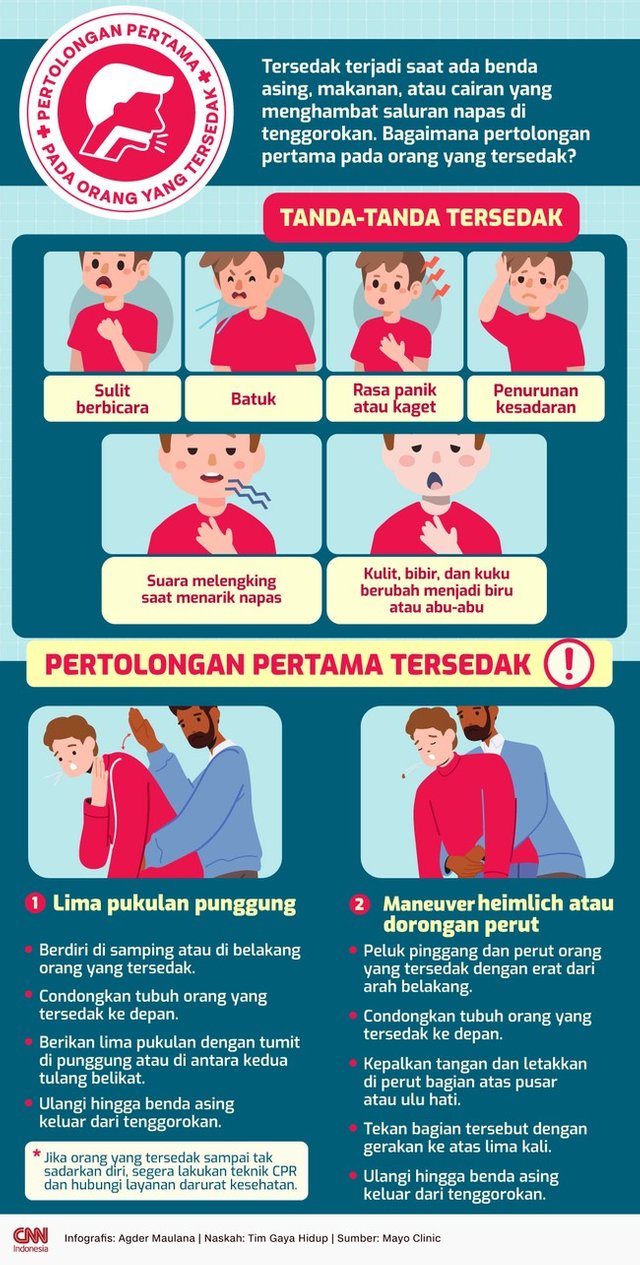SLC21/WK5: Choking and Airway Obstruction: A Complete Guide to Life-Saving First Aid Techniques

Hello Friends Steemian all, glad to be able to greet you back.
A useful and interesting lesson is presented again this week, this is a very useful lesson for us to know and understand. Especially for myself personally who is the father of 5 children who are still relatively small, not to mention I have a teacher who is always dealing with their behavior patterns. And the choking situation may be that I will experience and see, under certain conditions and situations.
Before I wrote this post, I read first everything that was explained in the lesson post. This is necessary so that I have a much better understanding of what the subject is so that later I can answer and elaborate well.
This week's lesson is choking and obstruction of the respiratory tract, let's just start with the description that I will explain in the following.
| Q1: Describe in detail the mechanism of choking. What happens physiologically when the airway is obstructed? List and explain the distinctive features or signs of choking, including how to differentiate between partial and complete obstruction. |
|---|
Choking mechanism.
Choking occurs when a foreign body blocks the airway, which causes difficulty breathing. Quoted from @abdu.navi03.
What I know and can conclude from what I have read, is that choking can occur and generally occurs when little or a lot of food and drink enters not into the esophagus, but into the respiratory tract. This happens due to the late epiglottis (tissue in the form of a valve) being closed, which is between the junction of the esophagus and throat.
Some cases of choking can also occur due to excessive talking or laughing and rising stomach acid, so that the epiglottis also does not have time to close.
What happens physiologically when the airway is blocked?
Back to what I read on the teaching team's post, that will be found and seen physiologically (body characteristics) when someone experiences a blocked airway caused by choking. Some of them are :
- A strong cough is the inability of a person to cough, speak, or cry.
- Noisy breathing is heard (wheezing) up to a silent attempt to be able to breathe.
- Cyanosis (blue skin).
- The gripping of the throat is due to no airflow at all.
- There is a decrease in the response of the nervous system so that panic and also tightness.
Name and describe the characteristic features or signs of choking partial and total blockage.
Choking or blockage can be divided into 2, namely partial and total blockage. There are differences in characteristics between them. Here are the points of difference.
▪️ Signs of partial blockage.
- limited airflow
- Strong cough.
- Choking/noisy breathing.
- Some ability to speak.
- Panic
▪️Signs of complete blockage
- There is no air flow.
- Silent attempts to breathe.
- Inability to cough / speak.
- Cyanosis (Blue Skin).
- Universal choking sign.
- Life-threatening.
| Q2: Demonstrate the Heimlich maneuver on a sibling, child, or peer (using safe simulations). Attach pictures of the demonstration and explain the procedure in detail, highlighting key points such as positioning, technique, and safety precautions. |
|---|
At this point, I took my son as an illustration to demonstrate the Heimlich maneuver. By being guided by the lessons I have read, and also from other sources that I consider correct to do.
🔴The first step is to make sure as soon as possible what happens, if the thing that happens is choking, then the right steps and procedures must be done immediately.

🔴Stand behind the person and wrap your arms around his waist, this is needed as support so that the victim does not fall later.

🔴Clench your fists and place them just above the navel, or below the chest cavity.

🔴Clasp your fist with your other hand and do 5 quick upward pushes, this aims to increase the air pressure in the chest cavity so that the air produced can push the blockage that occurs.

Here is the illustration.

Or can also do with the Back Blow technique as below :
.gif)
This technique is performed to provide strong pressure and vibration in the respiratory tract, which will effectively remove the blockage that occurs.
| Q3: Consider a situation where you encounter a conscious person choking on food. They are showing signs of cyanosis and restricted breathing. Describe how you will prioritize and manage the situation. Write each step in detail, from identifying choking to performing first aid and ensuring the victim's safety. Include how you would take control of the situation, communicate with bystanders, and seek medical assistance if needed. |
|---|
In principle, choking is a situation or situation where a victim experiences shortness and difficulty breathing, this is caused by the victim's respiratory tract being blocked by something, for example, food or other foreign objects. The impact is that the flow of air into the lungs of the victim will be problematic, and this must be handled immediately.
▪️ Identifying choking
For those of us who want to immediately help the victim, be sure to first identify the choking. In these cases we have seen that the victim has signs of cyanosis and restricted breathing, so we can take action, this is what is called 'assessing the situation'.
In the condition of cyanosis, the signs are :
- The victim will be seen holding his neck or called the universal choking sign.
- The second sign is difficulty speaking.
3._ Then cough._ - And further it is difficult to breathe.
- And the most obvious is that parts of the body such as the face, lips, and nails look blue.
- Make sure the victim is still conscious or has not responded.
▪️ First aid
If the victim can still respond.
If the victim is still able to respond then direct the patient to continue to try to cough, to clear the way to breathe on their own. But if you can't do it, then we can do first aid with first aid techniques by looking at the age of the victim. Examples of cases occur in children and adults.
A. Backside Punch:
Stand slightly behind the victim.
▪️ Support the victim's chest with one hand and lean the victim's body forward.
▪️ Give 5 sharp blows to the back, perform a blow between the shoulder blades using the heels of the hands.
B. Alternative two, the abdominal push technique
▪️ If less successful do the next step with the abdominal push technique (Heimlich maneuver), an example like the step guide above.
C. Alternate Backflow & Abdominal Thrusts
▪️ Continue by giving 5 backstrokes and 5 abdominal thrusts in turn until the object comes off or the person is no longer responsive.
If the victim can still respond.
If the child or adult victim is unable to respond, then the steps that can be taken are as follows :
- Immediately contact the nearest emergency services as soon as possible.
- Start performing CPR
- Try to do 30 compressions in the chest.
- And give 2 breaths of relief.
- Finally make sure the condition of the victim by checking the mouth for blockages after each cycle.
▪️ Controlling the situation
To know this will be okay, we must still see the condition of the victim if all has been resolved, but the right advice is still to seek medical help, this is to make sure there are no foreign objects that are still left and avoid further complications, even though the victim looks and he feels fine.
| Q4: Create an infographic (visual illustration) on handling choking emergencies. |
|---|
For correct and good results, my Infographic image was taken on one of the sites in Indonesia. Here is the infographic :

In the end, this is a very important lesson for all of us, as well as for myself. Where circumstances or situations like this can happen suddenly in our daily lives.
Finally, I invite @radjasalman, @pandora2010, and @simonnwigwe to participate, best regards to all of you, especially to @abdu.navi03 & @huzaifanaveed1.
| Period | 27 August to 27 November 2024 |
|---|---|
| Transfer to Vesting | 1,861.47 Steem |
| Cash Out | 0 Steem |
| Result | Club100 |
| CSI | 13.3 (0.00 % self, 78 upvotes, 60 accounts, last 7d) |

Student Name: @fantvwiki
Overall grade: 9.1
Plagiarism Check: Pass
AI Use: No
General Feedback: The student has shown an excellent nderstanding of this week's course. I enjoyed reading this post but there were a few shortcomings which I'm sure will be avoided in the upcoming posts. Good work
Thank you.
Regards,
@huzaifanaveed1
Thanks for the advice and support, have a nice day.